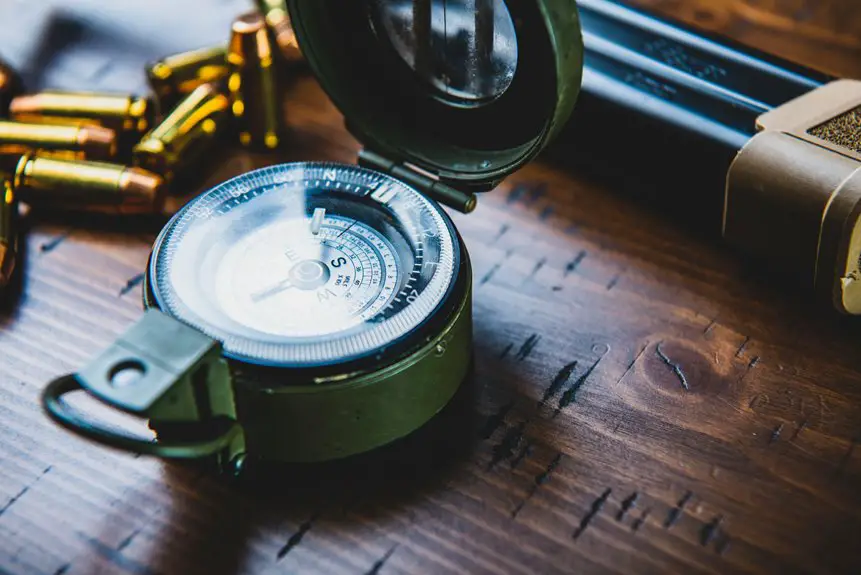You’ll want to start by choosing a durable, water-resistant fabric like heavy-duty nylon or canvas to protect your fishing rod. Measure your fully assembled rod accurately to guarantee a snug fit, then pick strong polyester thread and heavy-duty needles for sewing. Design a pattern with extra room for padding and plan secure closures, like zippers or Velcro, along with handy pockets for accessories. Keep going, and you’ll discover how to add durable features that safeguard your gear on every trip.
Table of Contents
Key Takeaways
- Select durable, water-resistant fabrics like heavy-duty nylon or canvas with waterproof coating for maximum rod protection.
- Measure fully assembled rods precisely, including reel and padding allowances, to ensure a snug, protective case fit.
- Use strong polyester or nylon thread and heavy-duty needles for sewing thick fabric layers securely.
- Design patterns with seam allowances, padding, and compartments for tools, ensuring reinforced stress points and functional storage.
- Attach secure closures such as zippers or Velcro with reinforced stitching and test fasteners for durability and ease of use.
Choosing the Right Fabric for Your Fishing Rod Case
When choosing the right fabric for your fishing rod case, consider durability and water resistance as your top priorities.
Durability and water resistance are essential when selecting fabric for your fishing rod case.
You want a material that can withstand rough handling and protect your gear from rain or splashes. Heavy-duty nylon or polyester fabrics with a water-resistant coating work great.
Canvas is another solid choice, offering excellent durability, though it may need additional waterproofing. Avoid lightweight or loosely woven fabrics—they won’t hold up well or shield your rods effectively.
Also, think about ease of cleaning; synthetic fabrics usually dry quickly and resist stains.
Picking a tough, water-resistant fabric guarantees your custom case will keep your fishing rods safe, dry, and ready for your next adventure.
Choose wisely, and your case will serve you well for many fishing trips to come.
Measuring Your Fishing Rods for a Perfect Fit
How do you guarantee your custom fishing rod case fits perfectly? Start by fully assembling your rod as you normally use it, including the reel if you plan to store it together.
Measure the entire length from the rod’s tip to the reel’s end. Add an extra inch or two for ease of insertion and removal.
Next, measure the widest part of your rod and reel combo to determine the case’s width. Don’t forget to account for any padding or lining you’ll add later—that thickness should be included in your measurements.
Finally, jot down these dimensions carefully. Accurate measurements assure your case protects your gear snugly without being too tight or too loose, giving you a tailor-made solution that fits your fishing rods perfectly every time.
Selecting the Appropriate Thread and Sewing Tools
Although choosing the right thread might seem simple, it plays an essential role in the durability and appearance of your custom fishing rod case.
Opt for a strong, polyester or nylon thread since these materials resist moisture and abrasion, perfect for outdoor gear. Avoid cotton thread—it’s weaker and less durable in wet conditions.
Choose durable polyester or nylon thread for moisture resistance; avoid weaker cotton in wet outdoor projects.
Next, select sewing tools that match your project’s needs. A sharp, heavy-duty needle, like a denim or leather needle, will easily penetrate thick fabrics and interfacing without breaking.
Also, use fabric scissors for clean cuts and pins or clips to hold layers firmly while sewing. Having a reliable sewing machine set to a medium stitch length will give your case strength and neatness.
With the right thread and tools, your case will protect your rods effectively and look professional.
Designing the Pattern for Your Custom Case
Creating a well-fitting pattern is the first step to guaranteeing your custom fishing rod case offers both protection and convenience. Start by measuring your fishing rod’s length and diameter, allowing extra room for padding and ease of movement.
Next, sketch the pattern on paper, including seam allowances and any compartments you want. Finally, double-check your measurements to avoid surprises during sewing.
Focus on these key points when designing your pattern:
- Accurate Measurements: Include rod length, reel size, and padding thickness to guarantee a snug fit.
- Seam Allowances: Add at least ½ inch for seams to maintain durability.
- Functional Features: Plan pockets or straps for accessories and easy transport.
A precise pattern saves time and guarantees your case fits perfectly.
Cutting Fabric Pieces Accurately
Once you have your pattern ready, cutting the fabric pieces accurately becomes essential to confirm your fishing rod case fits perfectly and holds up over time. Lay your fabric on a flat surface, pin the pattern securely, and use sharp fabric scissors or a rotary cutter for clean edges. Measure twice, cut once to avoid mistakes.
| Step | Tool Needed | Tip |
|---|---|---|
| Pin Pattern | Straight pins | Pin around edges evenly |
| Mark Outline | Fabric chalk/pencil | Mark clearly on fabric |
| Cut Fabric | Fabric scissors | Cut smoothly in one go |
| Check Pieces | Measuring tape | Confirm dimensions match |
Following these steps confirms precision and durability in your custom case.
Sewing the Main Body of the Rod Case
Now that you’ve cut your fabric pieces, it’s time to choose durable materials for the main body of your rod case.
Make sure you measure and cut carefully to keep everything aligned.
Then, use strong seam techniques to sew the pieces together securely.
Choosing Durable Fabrics
Because your fishing rod case needs to withstand rough handling and outdoor conditions, choosing durable fabrics is essential.
You want materials that resist tears, repel moisture, and endure frequent use without wearing out quickly. Here are three fabric options to evaluate:
- Cordura Nylon – Known for its high durability and abrasion resistance, it’s perfect for rugged outdoor gear.
- Heavy-Duty Canvas – Offers toughness and breathability, plus it ages well with a little water resistance.
- Ripstop Nylon – Lightweight yet strong, designed to prevent small tears from spreading.
Select a fabric that balances strength and weight to keep your rod protected without adding unnecessary bulk.
Cutting and Measuring
Start by measuring your fishing rod carefully to determine the exact dimensions needed for the main body of your case. Measure the rod length and add extra inches for seam allowance and ease. Next, mark your fabric using tailor’s chalk or a fabric marker, ensuring straight lines for a clean cut. Use sharp fabric scissors for precision. Accurate cutting guarantees a snug fit and protects your rod well.
| Emotion | Action | Result |
|---|---|---|
| Confidence | Measure precisely | Perfect fit |
| Satisfaction | Cut carefully | Clean edges |
| Anticipation | Mark fabric | Prepared steps |
| Pride | Work with care | Durable case |
This step sets the foundation for a custom, protective rod case you’ll be proud to use.
Sewing Seam Techniques
Having measured and cut your fabric with care, you’re ready to join the pieces by sewing the main body of your rod case. Start by aligning the fabric edges, making certain the right sides face each other.
Use a straight stitch to create strong, clean seams that will hold up under use. To reinforce durability, consider double-stitching key stress points.
Follow these steps for precise seam sewing:
- Pin the fabric edges evenly to prevent shifting while sewing.
- Sew with a consistent ½-inch seam allowance for balanced strength and flexibility.
- Press the seams open with an iron to reduce bulk and guarantee a flat finish.
Adding Padding for Extra Protection
While you might’ve a sturdy outer fabric, adding padding greatly boosts your fishing rod case’s ability to protect your gear from impacts and scratches.
Choose a lightweight, cushioned material like foam or quilt batting to line the inside of your case. Cut the padding to fit each panel precisely, ensuring full coverage without bulk.
Attach the padding securely by either sewing it between the outer fabric and lining or using fabric adhesive for a no-sew option. Make sure the padding stays flat and evenly distributed to prevent lumps that could damage your rod.
This extra layer absorbs shocks during transport and safeguards delicate rod components. Adding padding is a simple step that markedly enhances your case’s protective qualities, keeping your fishing gear safe on every adventure.
Creating Secure Closures and Fastenings
You’ll want to pick closures that keep your rod safe and easy to access, like zippers, Velcro, or snap buttons.
Make sure to attach fasteners firmly so they hold up over time and use.
Secure fastenings are key to preventing any slips or damage during transport.
Choosing Closure Types
Since your fishing rod case needs to protect your gear securely, choosing the right closure is essential. The closure type impacts both protection and ease of access.
Consider what fits your fishing style and how often you’ll open the case.
Here are three popular closure types to evaluate:
- Zippers – Offer a tight seal, keeping dust and moisture out. They’re reliable but can snag or break if not high-quality.
- Velcro – Easy to use and quick to open or close. Velcro is less secure but perfect for frequent access.
- Snap Buttons – Provide a firm hold and a classic look, but can be tricky to fasten with gloves on.
Pick the closure that balances security with convenience for your fishing adventures.
Attaching Fasteners Securely
Securely attaching fasteners guarantees your fishing rod case stays closed and protects your gear during transport.
Begin by marking the exact spots where you want to place snaps, Velcro, buttons, or zippers, making sure they align perfectly. Reinforce these areas with interfacing or extra fabric layers to prevent wear and tear.
When sewing, use strong, durable thread and double-stitch around fastener edges for added strength. For zippers, sew slowly and evenly to avoid puckering.
If you’re using snaps or buttons, press them firmly with proper tools to make sure they lock securely. Test each fastener multiple times before finishing to confirm they hold tight without damaging the fabric.
Taking these steps guarantees your case closes reliably, keeping your fishing rod safe and secure wherever you go.
Incorporating Pockets and Storage Options
Although the main purpose of your fishing rod case is to protect the rod, adding pockets and storage options makes it far more functional.
You’ll want to plan where these pockets go before sewing to guarantee they’re accessible and secure.
Consider these three essential storage ideas:
- Tool Pockets: Small, sturdy pockets for pliers, scissors, or line cutters keep your tools organized and within reach.
- Tackle Compartments: Larger pockets with secure closures can hold lures, hooks, and other tackle safely.
- Accessory Slots: Slim, flat pockets for items like extra line spools or a fishing license keep everything neat without bulk.
Final Touches: Reinforcing and Personalizing Your Case
Adding pockets and storage options enhances your fishing rod case’s usability, but guaranteeing its durability and personal flair is just as important.
Start by reinforcing stress points with extra stitching or fabric patches, especially around the seams and handles. Use heavy-duty thread to prevent wear and tear. Consider adding a waterproof lining or sealant to protect your gear from moisture.
To personalize your case, sew on patches, embroidery, or appliqués that reflect your style or favorite fishing spots. You can also attach a name tag or use fabric paint for custom designs.
Finally, check all closures and straps to verify they function smoothly, adjusting if needed. These final touches not only extend your case’s life but make it uniquely yours, combining practicality with personal expression.
Frequently Asked Questions
Can I Use Waterproof Fabric for My Fishing Rod Case?
You can definitely use waterproof fabric for your fishing rod case. It’ll keep your gear dry and protected from rain or splashes. Just make sure to choose a durable, flexible material for easy sewing and long-lasting use.
How Do I Clean and Maintain a Fabric Fishing Rod Case?
Like brushing off autumn leaves, you’ll want to shake out dirt and spot clean your fabric fishing rod case with mild soap and water. Air dry it fully to keep it fresh and ready for your next adventure.
What Is the Best Way to Transport My Rod Case on a Boat?
You should secure your rod case with straps or bungee cords to prevent slipping. Keep it in a dry, stable area away from heavy foot traffic. Using padded compartments can also protect your gear during boat rides.
Can This Sewing Method Be Adapted for Fly Fishing Rods?
You’ll find that same sewing method fits fly fishing rods perfectly since both need protection and flexibility. By adapting measurements, you’ll create a custom case that shields your delicate gear, making every fishing trip smoother and more enjoyable.
Are There Any Eco-Friendly Fabric Options for Making Rod Cases?
You can choose eco-friendly fabrics like organic cotton, hemp, or recycled polyester to make your rod case. These materials reduce environmental impact while providing durability and protection for your gear. You’ll feel good using them!







